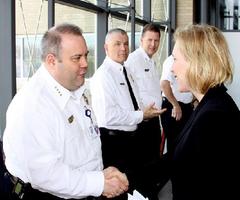Kirsten Gillibrand United States Senator for New York
Emergency Radio System for First Responders

New York is home to more than 2,300 police and fire departments that cannot all communicate with each other effectively during times of emergency – a fact underscored by the 9/11 Commission Report that identified insufficient interoperability among communications systems used by first responders during the attacks and rescue efforts.
Firefighters, police officers, emergency medical technicians, and other public safety professionals currently communicate on different frequencies and with different systems, creating barriers to providing a coordinated and efficient response during an emergency situation.
The solution to this national security problem hasn’t languished due to a lack of technological know-how. The technology exists today. It has languished due to a lack of political will – even as President Obama identified this as a priority in his 2011 State of the Union address, calling for the development and deployment of a nationwide wireless broadband network.
Congress cannot afford to wait another day to implement common sense legislation that would enable all of our emergency responders to communicate with each other in real time during a national crisis. Senator Gillibrand is urging Congress to come together before the 10th anniversary of the 9/11 attacks and pass the Public Safety Spectrum and Wireless Innovation Act.
The legislation creates the framework for the deployment of a nationwide, interoperable, wireless broadband network for public safety by allocating 10 megahertz of spectrum, known as the “D-block,” to public safety. This nationwide interoperable broadband network would finally enable first responders to communicate across jurisdictions, share critical data such as video feeds and up-to-date information in real-time – making complex operations easier and safer.
The “D-block” would arm our men and women on the ground with the technology needed to share and disseminate information quickly and seamlessly, including receiving background checks, fingerprints, photos, and videos instantly. Firefighters would be able to receive high speed file downloads, including floor plans for a burning building. Police officers could use a handheld device to look up outstanding warrants before arriving at a location. EMS workers could exchange diagnostic information about a victim with doctors while en route to the hospital.





![New York City - Creative Commons Photo attribution: george clooney Original uploader was Jleon at [www.google.com]](https://www.webharvest.gov/congress113th/20141205211708im_/http://www.gillibrand.senate.gov/images/contact/office_nyc.jpg)


